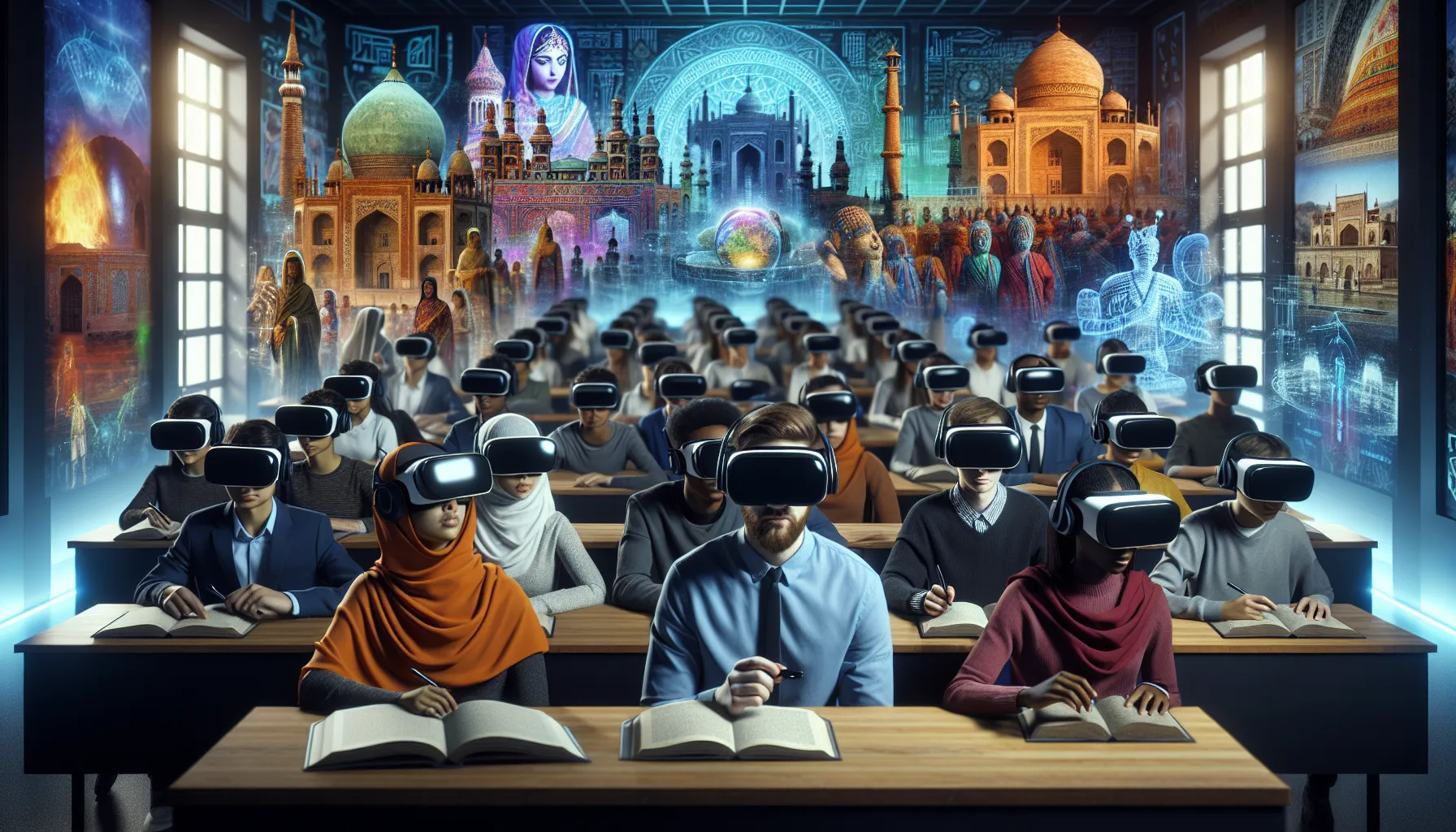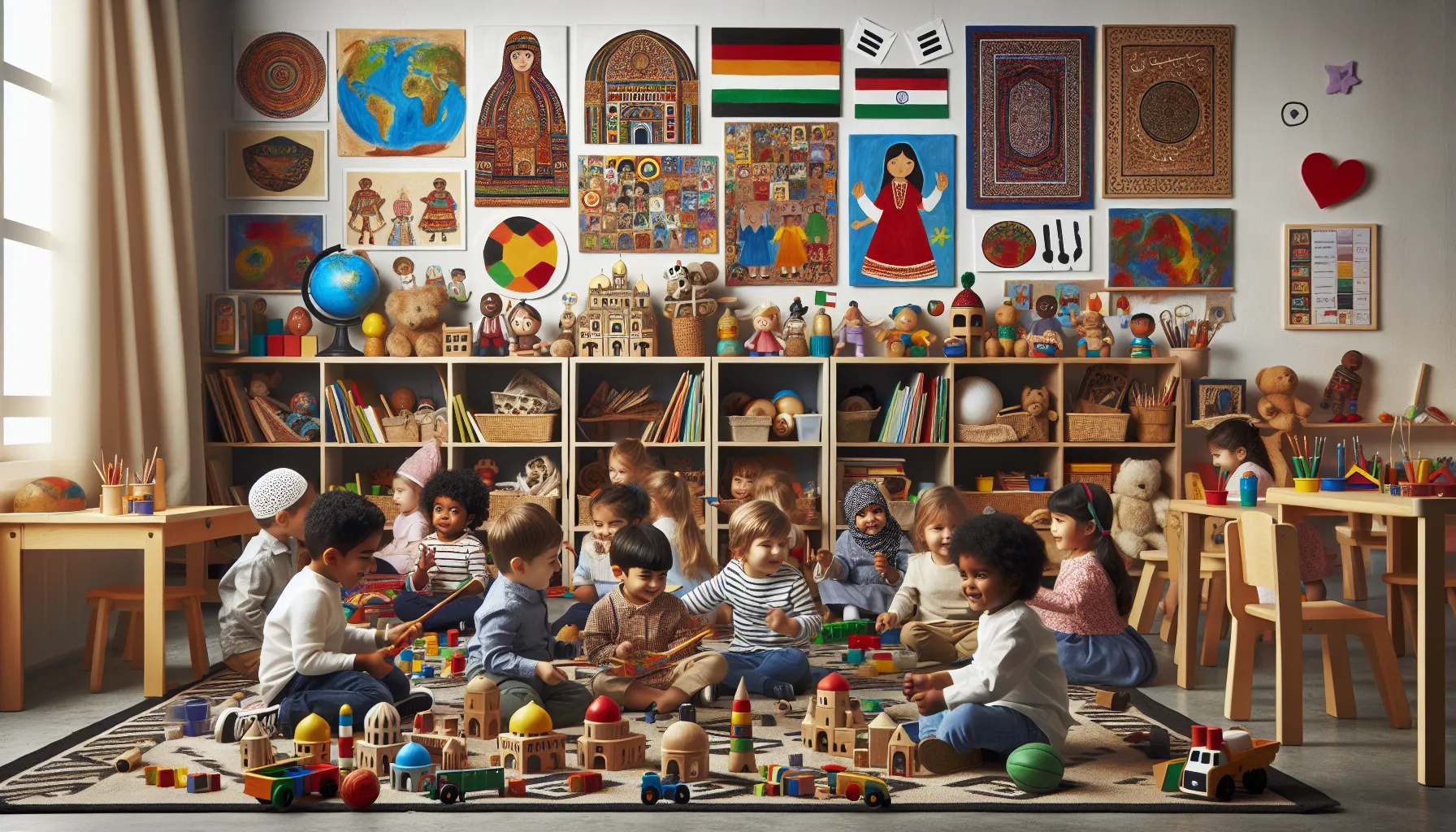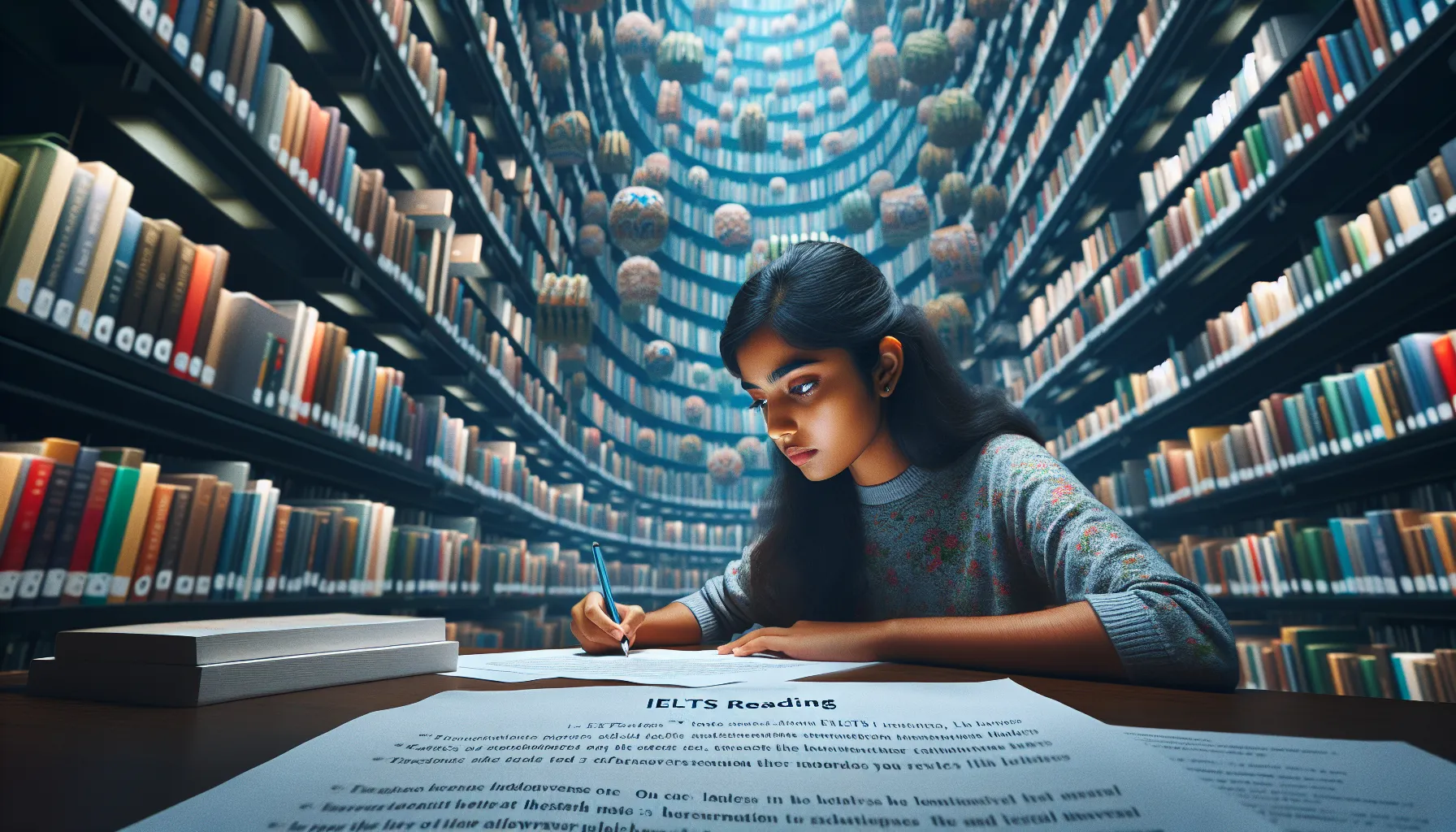Welcome to our IELTS Reading practice session focused on the fascinating topic of “How Virtual Reality is Enhancing Cultural Education.” As an experienced IELTS instructor, I’ve crafted this comprehensive practice test to help you sharpen your reading skills while exploring an innovative subject in education. Let’s dive into the world of virtual reality and its impact on cultural learning!
Table Of Contents
- Introduction to the Topic
- IELTS Reading Practice Test
- Passage 1 – Easy Text
- Virtual Reality: A New Frontier in Cultural Education
- Questions 1-7
- Questions 8-13
- Passage 2 – Medium Text
- The Impact of Virtual Reality on Cultural Heritage Preservation and Education
- Questions 14-19
- Questions 20-26
- Passage 3 – Hard Text
- Virtual Reality and the Reconceptualization of Cultural Spaces
- Questions 27-32
- Questions 33-40
 Virtual Reality Classroom
Virtual Reality Classroom
Introduction to the Topic
Virtual Reality (VR) technology has been making waves in various fields, and education is no exception. In recent years, VR has emerged as a powerful tool for enhancing cultural education, offering immersive experiences that bring distant cultures and historical periods to life. This practice test will explore how VR is revolutionizing the way we learn about and interact with different cultures, making the learning process more engaging and effective.
IELTS Reading Practice Test
Passage 1 – Easy Text
Virtual Reality: A New Frontier in Cultural Education
Virtual Reality (VR) is transforming the landscape of cultural education, offering students and learners unprecedented opportunities to explore and experience diverse cultures from around the world. This immersive technology is breaking down geographical barriers and time constraints, allowing users to virtually visit historical sites, museums, and cultural events with just a headset and a computer.
One of the primary advantages of VR in cultural education is its ability to create a sense of presence. Unlike traditional methods of learning about different cultures through books or videos, VR provides a three-dimensional, interactive environment that makes users feel as if they are actually present in the location they are studying. This heightened sense of immersion can lead to improved retention of information and a deeper understanding of cultural nuances.
Museums and cultural institutions are increasingly adopting VR technology to enhance their educational offerings. For example, the British Museum in London has developed VR experiences that allow visitors to explore ancient civilizations, such as Bronze Age Britain, in stunning detail. Users can virtually handle artifacts, walk through reconstructed settlements, and even witness historical events as if they were happening in real-time.
Language learning is another area where VR is making significant strides in cultural education. Virtual language immersion programs enable students to practice their language skills in simulated real-world environments, such as ordering food in a French café or haggling in a Mexican market. This contextual learning approach helps students not only improve their language proficiency but also gain valuable insights into the cultural practices and social norms of the target language’s speakers.
Furthermore, VR is proving to be an effective tool for promoting empathy and cross-cultural understanding. By allowing users to literally “walk in someone else’s shoes,” VR experiences can foster a greater appreciation for different cultural perspectives and challenges. For instance, VR documentaries have been created to show the daily lives of refugees or indigenous communities, helping viewers develop a more nuanced understanding of global issues and diverse ways of life.
As VR technology continues to advance and become more accessible, its potential to revolutionize cultural education grows exponentially. From virtual field trips to interactive historical reenactments, VR is opening up new avenues for learning that were previously unimaginable. By bridging the gap between abstract knowledge and lived experience, VR is set to play an increasingly important role in shaping our understanding of the world’s rich cultural tapestry.
Questions 1-7
Do the following statements agree with the information given in the passage?
Write
TRUE if the statement agrees with the information
FALSE if the statement contradicts the information
NOT GIVEN if there is no information on this
- Virtual Reality allows users to physically touch historical artifacts.
- The British Museum offers VR experiences of ancient civilizations.
- VR language learning programs are less effective than traditional classroom methods.
- Virtual Reality can help users develop empathy for people from different cultures.
- All major museums worldwide have adopted VR technology for their exhibits.
- VR experiences can recreate historical events for users to witness.
- The cost of VR technology is the main barrier to its widespread adoption in education.
Questions 8-13
Complete the sentences below.
Choose NO MORE THAN TWO WORDS from the passage for each answer.
- Virtual Reality creates a sense of __ that makes users feel they are actually in the location they are studying.
- The __ environment provided by VR can lead to better retention of information.
- VR allows users to explore __ in detail, such as Bronze Age Britain.
- __ programs in VR help students practice language skills in simulated real-world settings.
- VR experiences can help viewers develop a more __ understanding of global issues.
- As VR becomes more advanced and __, its potential to transform cultural education increases.
Passage 2 – Medium Text
The Impact of Virtual Reality on Cultural Heritage Preservation and Education
The advent of Virtual Reality (VR) technology has ushered in a new era for cultural heritage preservation and education. This innovative tool is not only revolutionizing the way we experience and learn about cultural artifacts and historical sites but also playing a crucial role in their conservation and accessibility. As museums, educational institutions, and cultural organizations embrace VR, they are discovering its potential to engage audiences, preserve fragile heritage, and democratize access to cultural knowledge.
One of the most significant contributions of VR to cultural heritage is its ability to create detailed, immersive reconstructions of historical sites and artifacts. These virtual recreations serve multiple purposes, from education and research to preservation and restoration. For instance, the Zamani Project, led by the University of Cape Town, has been using advanced 3D scanning techniques to create highly accurate digital models of African heritage sites. These models can be explored through VR, allowing researchers and the public to study intricate details of structures that may be inaccessible or at risk of degradation in the real world.
Moreover, VR is proving invaluable in the preservation of intangible cultural heritage, such as traditional dances, rituals, and oral histories. By capturing these practices in immersive 360-degree video and audio, VR can create a lasting record that future generations can experience and learn from. This is particularly important for endangered cultural practices that may be at risk of being lost as older generations pass away.
In the realm of education, VR is transforming the way students engage with cultural content. Traditional methods of learning about different cultures often rely on passive consumption of information through textbooks or documentaries. In contrast, VR offers an active, experiential learning approach that can significantly enhance understanding and retention. For example, students studying ancient Egyptian civilization can now virtually explore the pyramids of Giza, examining hieroglyphics up close and even witnessing the construction process through time-lapse simulations.
The gamification of cultural learning through VR is another exciting development. Educational VR experiences are increasingly incorporating game-like elements, such as quests, puzzles, and rewards, to make learning more engaging and interactive. This approach not only makes cultural education more appealing to younger generations but also encourages active problem-solving and critical thinking skills.
Furthermore, VR is breaking down geographical and economic barriers to cultural experiences. Virtual museum tours and exhibitions allow people from around the world to access collections and artifacts that they might never have the opportunity to see in person. This democratization of cultural knowledge has the potential to foster greater global understanding and appreciation for diverse heritage.
However, the integration of VR in cultural heritage preservation and education is not without challenges. Ethical considerations arise when recreating sensitive historical events or sacred sites, requiring careful curation and consultation with relevant communities. Additionally, the digital divide remains a concern, as access to VR technology is not yet universal, potentially creating new inequalities in cultural education.
Despite these challenges, the potential of VR to enhance cultural heritage preservation and education is immense. As the technology continues to evolve and become more accessible, we can expect to see even more innovative applications that bridge the gap between past and present, bringing the richness of human cultural heritage to life in ways previously unimaginable.
Questions 14-19
Choose the correct letter, A, B, C, or D.
-
According to the passage, one of the main benefits of VR in cultural heritage is:
A) Its ability to physically restore damaged artifacts
B) Its potential to create immersive reconstructions of historical sites
C) Its capacity to replace traditional museum visits
D) Its use in creating new cultural artifacts -
The Zamani Project is mentioned as an example of:
A) A virtual reality gaming platform
B) A project using 3D scanning to create digital models of heritage sites
C) A new method of physical restoration for African monuments
D) An educational program for university students -
In the context of intangible cultural heritage, VR is valuable because:
A) It can prevent traditional practices from changing
B) It allows for the modification of cultural practices
C) It creates a permanent record of practices that might otherwise be lost
D) It replaces the need for real-world cultural experiences -
The passage suggests that VR in education:
A) Should completely replace traditional learning methods
B) Is less effective than textbook learning
C) Offers a more active and experiential approach to learning
D) Is only suitable for studying ancient civilizations -
The concept of gamification in VR cultural learning is described as:
A) A distraction from serious learning
B) An approach that incorporates game-like elements to engage learners
C) A method only suitable for young children
D) A way to simplify complex cultural concepts -
The passage identifies which of the following as a challenge in using VR for cultural heritage?
A) The inability to accurately recreate historical sites
B) The lack of interest from educational institutions
C) The potential creation of new inequalities due to uneven access to technology
D) The complete replacement of physical cultural experiences
Questions 20-26
Complete the summary below.
Choose NO MORE THAN TWO WORDS from the passage for each answer.
Virtual Reality (VR) is revolutionizing cultural heritage preservation and education by offering 20 __ of historical sites and artifacts. This technology is particularly useful for studying details of structures that may be 21 __ or at risk in the real world. VR also helps preserve 22 __, such as traditional dances and oral histories, creating lasting records for future generations.
In education, VR provides an 23 __ approach to learning about different cultures, enhancing understanding and retention. The 24 __ of cultural learning through VR, which incorporates game-like elements, makes the experience more engaging and interactive.
VR is also democratizing access to cultural knowledge by enabling virtual tours and exhibitions, although there are concerns about the 25 __ and potential new inequalities in access to these experiences. Despite challenges, including 26 __ when recreating sensitive historical events, VR’s potential to enhance cultural heritage preservation and education is significant.
Passage 3 – Hard Text
Virtual Reality and the Reconceptualization of Cultural Spaces
The integration of Virtual Reality (VR) technology into cultural education and heritage preservation is catalyzing a profound reconceptualization of cultural spaces and the way we interact with historical and artistic content. This technological revolution is not merely augmenting existing educational paradigms but is fundamentally altering the ontological status of cultural artifacts and our epistemological approach to understanding diverse cultures and histories.
At the forefront of this transformation is the notion of spatial temporality in cultural experiences. Traditional museums and heritage sites are bound by physical constraints, presenting a static, often decontextualized view of artifacts and historical narratives. VR, however, introduces a dynamic temporal dimension, allowing users to traverse both space and time within a single experience. For instance, the Timelooper project enables visitors to historical sites to witness key events that occurred in those locations centuries ago, superimposing virtual reconstructions onto the present-day physical environment. This palimpsestic approach to cultural spaces creates a multi-layered understanding of history, where past and present coalesce in a rich, immersive narrative.
Moreover, VR is challenging the conventional curatorial practices of cultural institutions. The democratization of curation through VR platforms allows for multiple interpretations and presentations of cultural heritage, moving away from the singular, authoritative narratives often presented in traditional settings. Users can now curate their own experiences, selecting viewpoints, time periods, and even alternative historical scenarios, fostering a more pluralistic engagement with cultural content. This shift raises intriguing questions about the nature of authenticity in cultural experiences and the role of individual interpretation in understanding collective heritage.
The haptic dimension of VR in cultural education presents another frontier in the reconceptualization of cultural spaces. Advanced haptic feedback systems, when integrated with VR, can simulate the tactile properties of artifacts, allowing users to ‘touch’ and manipulate virtual objects. This sensory engagement transcends the visual and auditory limitations of traditional cultural education methods, creating a more holistic, embodied learning experience. The implications of this technology extend beyond mere simulation; they challenge our understanding of the materiality of cultural heritage and the boundaries between physical and virtual cultural spaces.
Furthermore, VR is facilitating unprecedented levels of cross-cultural dialogue and collaborative heritage interpretation. Virtual spaces can serve as neutral grounds for diverse cultural stakeholders to meet, discuss, and collectively interpret shared heritage. This is particularly significant for contested heritage sites or artifacts, where VR can provide a platform for multiple narratives to coexist and be explored without physical or political constraints. The virtual repatriation of cultural artifacts, allowing source communities to interact with digitized versions of their heritage held in distant museums, exemplifies this potential for cultural reconciliation and collaborative stewardship.
However, the integration of VR in cultural spaces also presents complex ethical and philosophical challenges. The question of digital authenticity becomes paramount: how do we ensure that virtual representations of cultural heritage maintain the integrity and significance of the original? There are concerns about the commodification of culture through VR experiences, potentially trivializing sacred or sensitive cultural elements. Additionally, the digital divide in access to VR technology raises issues of equity in cultural education and representation.
The phenomenological implications of VR in cultural spaces are equally profound. As users become increasingly immersed in virtual cultural experiences, the boundaries between observer and participant blur, challenging traditional notions of cultural spectatorship. This immersive participation has the potential to foster deeper empathy and understanding across cultures, but it also raises questions about the nature of cultural identity and the role of physical presence in cultural experiences.
In conclusion, the integration of VR into cultural education and heritage preservation is not just a technological advancement but a paradigm shift in how we conceptualize and interact with cultural spaces. It offers unprecedented opportunities for immersive, interactive, and pluralistic engagements with cultural heritage, while also presenting complex challenges to traditional notions of authenticity, curation, and cultural identity. As this technology continues to evolve, it will undoubtedly play a crucial role in shaping our understanding of culture, history, and our place within the global cultural landscape.
Questions 27-32
Choose the correct letter, A, B, C, or D.
-
According to the passage, the concept of spatial temporality in VR allows users to:
A) Physically alter historical sites
B) Experience different time periods in a single location
C) Create new historical events
D) Permanently change the appearance of cultural artifacts -
The Timelooper project is mentioned as an example of:
A) A virtual museum collection
B) A historical reenactment program
C) A VR experience that overlays historical events on present-day sites
D) A time travel simulation -
The democratization of curation through VR is described as:
A) A way to replace professional curators
B) A method to create more accurate historical narratives
C) An approach allowing multiple interpretations of cultural heritage
D) A technique to simplify complex historical events -
The haptic dimension of VR in cultural education is significant because it:
A) Replaces the need for physical artifacts
B) Allows users to physically alter virtual objects
C) Provides a more comprehensive sensory learning experience
D) Is only useful for studying ancient civilizations -
Virtual repatriation of cultural artifacts refers to:
A) The physical return of artifacts to their countries of origin
B) The creation of exact physical replicas of artifacts
C) Allowing source communities to interact with digital versions of their heritage
D) The legal process of claiming ownership of cultural objects -
The passage suggests that the phenomenological implications of VR in cultural spaces include:
A) The complete replacement of physical cultural experiences
B) A blurring of the lines between observer and participant
C) The elimination of cultural differences
D) A decrease in empathy towards other cultures
Questions 33-40
Complete the summary below.
Choose NO MORE THAN TWO WORDS from the passage for each answer.
Virtual Reality is revolutionizing cultural education by introducing the concept of 33 __, which allows users to experience different historical periods in one location. This creates a 34 __ approach to understanding cultural spaces, where past and present are combined.
VR is also changing curatorial practices, leading to a 35 __ of curation, which allows for multiple interpretations of cultural heritage. The integration of 36 __ systems in VR provides a more comprehensive sensory experience, challenging our understanding of the materiality of cultural heritage.
VR facilitates 37 __ and collaborative interpretation of heritage, particularly useful for contested sites. However, it also raises questions about 38 __ in virtual representations and the potential 39 __ of culture through VR experiences.
The 40 __ of VR in cultural spaces blur the line between observer and participant, potentially fostering greater empathy but also raising questions about cultural identity and the importance of physical presence in cultural experiences.



